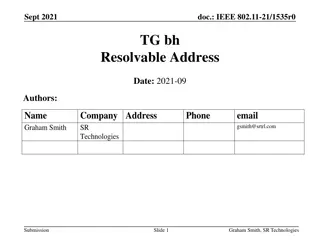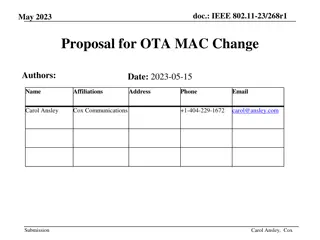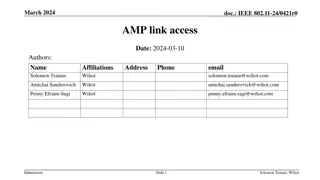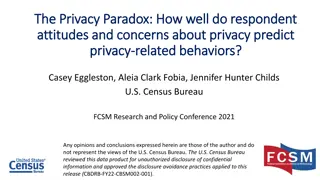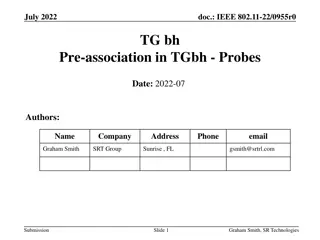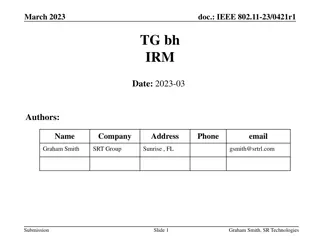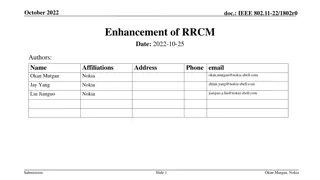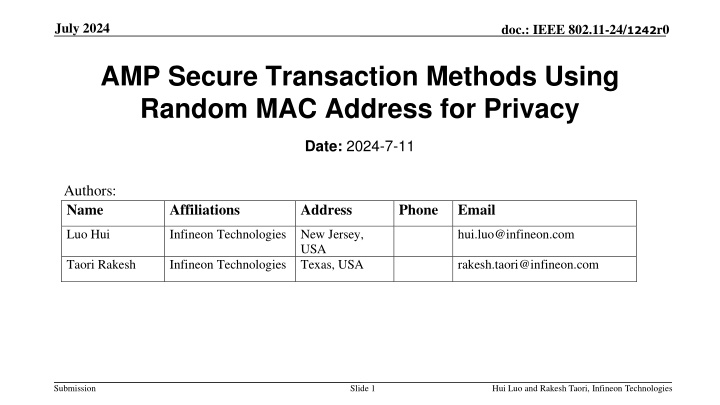
Secure Transaction Methods Using Random MAC Address for Privacy in AMP Devices
"Explore secure transaction methods for AMP devices in IEEE 802.11 standards, focusing on privacy protection through random MAC addresses. The presentation discusses shared secret-based and server-managed transaction methods, considering the communication model, power efficiency, and streamlined transaction processes to enhance security and efficiency for AMP devices." (280 characters)
Download Presentation

Please find below an Image/Link to download the presentation.
The content on the website is provided AS IS for your information and personal use only. It may not be sold, licensed, or shared on other websites without obtaining consent from the author. If you encounter any issues during the download, it is possible that the publisher has removed the file from their server.
You are allowed to download the files provided on this website for personal or commercial use, subject to the condition that they are used lawfully. All files are the property of their respective owners.
The content on the website is provided AS IS for your information and personal use only. It may not be sold, licensed, or shared on other websites without obtaining consent from the author.
E N D
Presentation Transcript
July 2024 doc.: IEEE 802.11-24/1242r0 AMP Secure Transaction Methods Using Random MAC Address for Privacy Date: 2024-7-11 Authors: Name Affiliations Address Phone Email Luo Hui Infineon Technologies New Jersey, hui.luo@infineon.com USA Taori Rakesh Infineon Technologies Texas, USA rakesh.taori@infineon.com Submission Slide 1 Hui Luo and Rakesh Taori, Infineon Technologies
July 2024 doc.: IEEE 802.11-24/1242r0 Summary A shared secret-based secure transaction method for AMP devices (11-24/0178), a server- managed secure transaction method for AMP devices (11-24/0526), and AMP device-initiated secure transaction methods (11-24/0871) are briefly reviewed. This presentation describes how to add privacy protection in above methods for AMP devices and the normally powered Wi-Fi devices communicating with them, by using random MAC addresses on both devices. Submission Slide 2 Hui Luo and Rakesh Taori, Infineon Technologies
July 2024 doc.: IEEE 802.11-24/1242r0 What is a suitable communication model for AMP devices? If an AMP device follows current Wi-Fi MAC (maintaining a secure link for layered networking model) It will take 10+ frames to establish a secure association. The AMP device needs to have sufficient power to maintain the secure association and low power operating mode (e.g., TSF timer). Questions Do AMP devices have sufficient power for such overhead? The layered networking model was designed to support many applications, possibly with large-volume data exchanges over long time. Do AMP devices need these? Arguments Layered networking model over conventional Wi-Fi MAC may not be the best fit for AMP devices that are often designed for a single application. Compact transaction-based communication model may be better. Submission Slide 3 Hui Luo and Rakesh Taori, Infineon Technologies
July 2024 doc.: IEEE 802.11-24/1242r0 A shared secret-based secure transaction method for AMP devices Assumptions AMP devices typically support one application (function). AMP devices do not have large data volume to exchange at each transaction. AMP devices do not need to maintain association and/or low power mode (they can simply power off or lose the power after communication). Initial ideas A simple Request (by regular STA) + Response (by AMP device) transaction model. Integrated security based on a shared secret between the requester (regular STA) and the respondent (AMP device). Absolutely minimize exchanged messages during the aforementioned secure data transaction. Solution Only 4 message exchanges are needed to finish secure transaction. Can co-exist with layered networking model over conventional MAC. Submission Slide 4 Hui Luo and Rakesh Taori, Infineon Technologies
July 2024 doc.: IEEE 802.11-24/1242r0 A server-managed secure transaction method for AMP devices Use case An entity owning many deployed AMP devices may want to dynamically allow/disallow reading devices to access deployed AMP devices. Example: a contractor s reading device may need the access, and the access right should be removed after finishing the contract. Shared secret between a reading device and an AMP device is no longer suitable. It is impractical to maintain and update identifiers and shared secrets for different reading devices on every AMP device, especially deployed AMP devices. Solution Let a server manage access rights dynamically without touching deployed AMP devices. Submission Slide 5 Hui Luo and Rakesh Taori, Infineon Technologies
July 2024 doc.: IEEE 802.11-24/1242r0 A shared secret-based AMP device-initiated secure transaction method with complicated initiation message Use case The AMP device could be a glass breaking sensor, must initiate the communication to report an alarm. Assumptions The Wi-Fi reading device and the AMP device share a secret code, which is the foundation of the secure transaction. The AMP device can afford the energy of repeatedly sending a complicated Init_Request message until the message is detected by the reading device. Solution Only 3 message exchanges are needed to finish mutual authentication and encrypted data exchange. Submission Slide 6 Hui Luo and Rakesh Taori, Infineon Technologies
July 2024 doc.: IEEE 802.11-24/1242r0 A shared secret-based AMP device-initiated secure transaction method with simple initiation message Assumptions The Wi-Fi reading device and the AMP device share a secret code, which is the foundation of the secure transaction. The AMP device has very limited power, needing to preserve energy as long as possible while sending the Init_Request message. Solution 5 message exchanges are needed to finish mutual authentication and encrypted data exchange, with the first Init_Request message being very simple using a special PHY/MAC method to preserve energy. Submission Slide 7 Hui Luo and Rakesh Taori, Infineon Technologies
July 2024 doc.: IEEE 802.11-24/1242r0 A server-managed AMP device-initiated secure transaction method with complicated initiation message Use case An entity (e.g., a mall) owning many deployed AMP sensors may want to dynamically allow/disallow reading devices (e.g., stores reading devices) to access those AMP devices based on contract terms, without changing anything in the deployed AMP devices. Assumptions The owner s server and every AMP device share a secret code, which is the foundation of the secure transaction. The reading device cannot know the secret code. Every reading device has a user id and a credential managed by the server. The server determines if a reading device can access any AMP device based on such information. An AMP device can afford the energy of repeatedly sending a complicated Init_Request message until the message is detected by the reading device. Solution Only 3 message exchanges are needed to finish mutual authentication and encrypted data exchange between an authorized reading device and an AMP device. Submission Slide 8 Hui Luo and Rakesh Taori, Infineon Technologies
July 2024 doc.: IEEE 802.11-24/1242r0 A server-managed AMP device-initiated secure transaction method with simple initiation message Assumptions The owner s server and every AMP device share a secret code, which is the foundation of the secure transaction. The reading device cannot know the secret code. Every reading device has a user id and a credential managed by the server. The server determines if a reading device can access any AMP device based on such information. An AMP device has very limited power, needing to preserve energy as long as possible while sending the Init_Request message. Solution 5 message exchanges are needed to finish mutual authentication and encrypted data exchange, with the first Init_Request message being very simple using a special PHY/MAC method to preserve energy. Submission Slide 9 Hui Luo and Rakesh Taori, Infineon Technologies
July 2024 doc.: IEEE 802.11-24/1242r0 A shared secret-based reading device-initiated secure transaction method with privacy Assumptions A reading device R and an AMP device A has a shared secret. A has a confidential name A_ID. R knows A_ID. Solution R sends the hash value of A_ID in ID_Request using random address R1 as source address and broadcast address as destination address. Every AMP device near R receives ID_Request and computes the hash value using its own name. Only A finds the computed hash value matches the received hash value. A sends back ID_Response using random address R2 as source address and R1 as destination address. R and A follow the shared secret-based reading device-initiated secure transaction method to finish the communication, with R1 and R2 as their MAC addresses. Highlights Only 4 message exchanges to finish secure transaction with privacy. Can co-exist with current Wi-Fi secure link with privacy based on IRM. Submission Slide 10 Hui Luo and Rakesh Taori, Infineon Technologies
July 2024 doc.: IEEE 802.11-24/1242r0 A server-managed reading device-initiated secure transaction method with privacy Assumptions A server S owns many deployed AMP devices, including A. S and A shares a secret. A has a confidential name A_ID. A reading device R has registered on S with R_ID and R_credential. S manages whether R can access A based on such registered information. R knows A_ID. Solution R sends the hash value of A_ID in ID_Request using random address R1 as source address and broadcast address as destination address. Every AMP device near R receives ID_Request and computes the hash value using its own name. Only A finds the computed hash value matches the received hash value. A sends back ID_Response using random address R2 as source address and R1 as destination address. R and A follow the server-managed reading device- initiated secure transaction method to finish the communication using R1 and R2 as their MAC addresses. Submission Slide 11 Hui Luo and Rakesh Taori, Infineon Technologies
July 2024 doc.: IEEE 802.11-24/1242r0 A shared secret-based AMP device-initiated secure transaction method with privacy Assumptions A reading device R and an AMP device A has a shared secret. A has a confidential name A_ID. R knows A_ID. A may has R s public key if R has share secrets with a lot of AMP devices (otherwise it is not needed). Solution A sends Init_Request with A_ID encrypted using R s public key or hashed, using a random address R1 as source address and a broadcast address as destination address. Every reading device near A tries to decrypt A_ID or matches the hashed value using AMP device names stored in memory. Only R can decrypt A_ID or find the match. R then sends Data_Request using a random address R2 as source address and R1 as destination address. R and A follow the shared secret-based AMP device-initiated secure transaction method to finish the communication, with R2 and R1 as their MAC addres Two scenarios There could be two scenarios: (1) A can afford to sends a complicated Init_Request; and (2) A can only send a simple Init_Request. Encrypted or hashed A_ID is included in Init_Request for both scenarios. Submission Slide 12 Hui Luo and Rakesh Taori, Infineon Technologies
July 2024 doc.: IEEE 802.11-24/1242r0 A server-managed AMP device-initiated secure transaction method with privacy Assumptions A server S identified as S_URL owns many deployed AMP devices, including A. A stores S_URL and S s public key in its non-volatile memory. S and A shares a secret. A has a confidential name A_ID. A reading device R has registered on S with R_ID and R_credential. S manages whether R can access A based on such information. R does not know A_ID. Solution A sends Init_Request with a session_id, S_URL, and A_ID encrypted using S s public key, using a random address R1 as source address and a broadcast address as destination address. Every reading device near A and registering on S forwards the content of Init_Request to S. S only responds to the first reading device based on session_id, assuming it is R without loss of generality. S decrypts A_ID, generates security parameters needed by Data_Request based on the secret shared with A, and sends the parameters to R. R then sends Data_Request using a random address R2 as source address and R1 as destination address. R and A follow the server-managed AMP device-initiated secure transaction method to finish the communication, with R2 and R1 as their MAC address. Two scenarios There could be two scenarios: (1) A can afford to sends a complicated Init_Request; and (2) A can only send a simple Init_Request. Encrypted A_ID and S_URL are included in Init_Request for both scenarios. Submission Slide 13 Hui Luo and Rakesh Taori, Infineon Technologies
July 2024 doc.: IEEE 802.11-24/1242r0 Conclusions Privacy protection is added to all scenarios of secure transactions for AMP devices, including: Shared secret-based reading device-initiated secure transaction; Server-managed reading device-initiated secure transaction; Shared secret-based AMP device-initiated secure transaction with a simple initiation message and with a complicated initiation message, depending on AMP device s power constraint. Server-managed AMP device-initiated secure transaction with a simple initiation message and with a complicated initiation message, depending on AMP device s power constraint. No extra frame is needed for privacy protection. All secure transactions with privacy protection can finish using 3 to 5 frames exchanged with an AMP device. All these compact transaction-based secure AMP device communications methods with privacy protection can co-exist with current Wi-Fi MAC security solution using IRM for privacy. Submission Slide 14 Hui Luo and Rakesh Taori, Infineon Technologies


